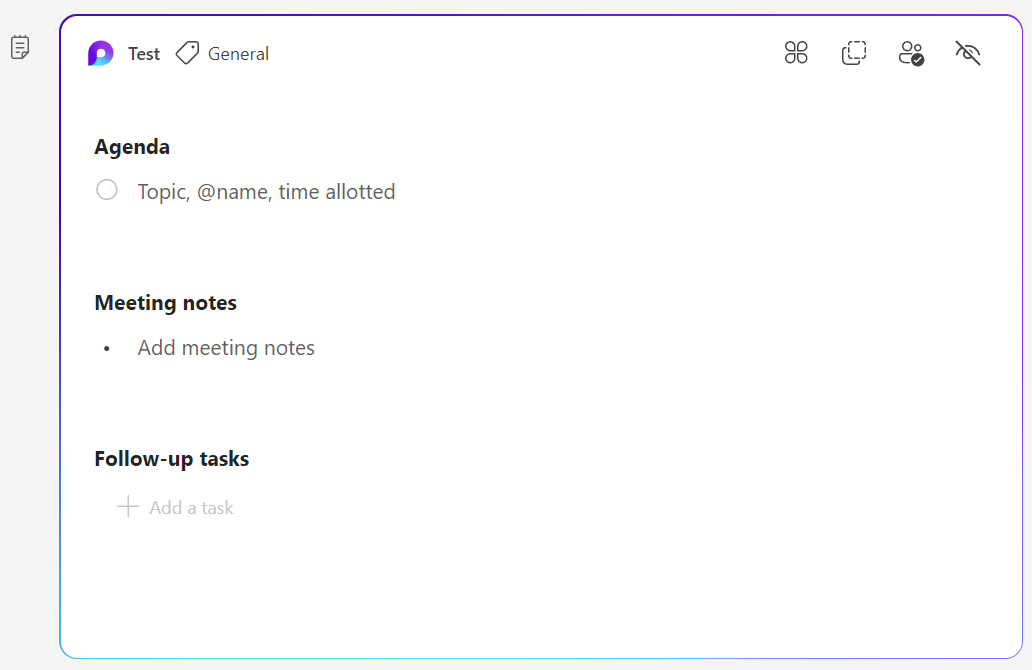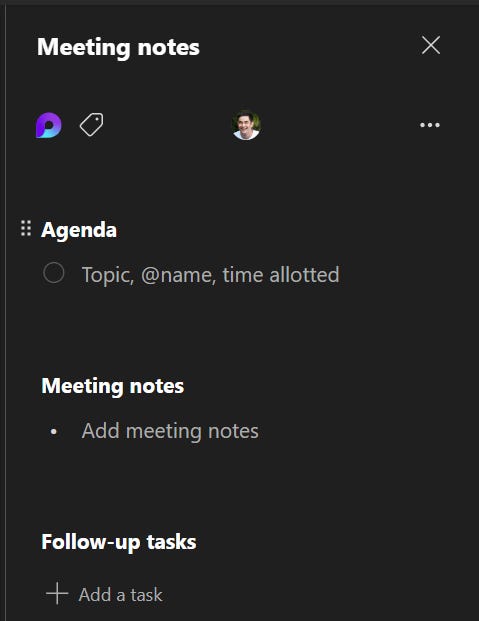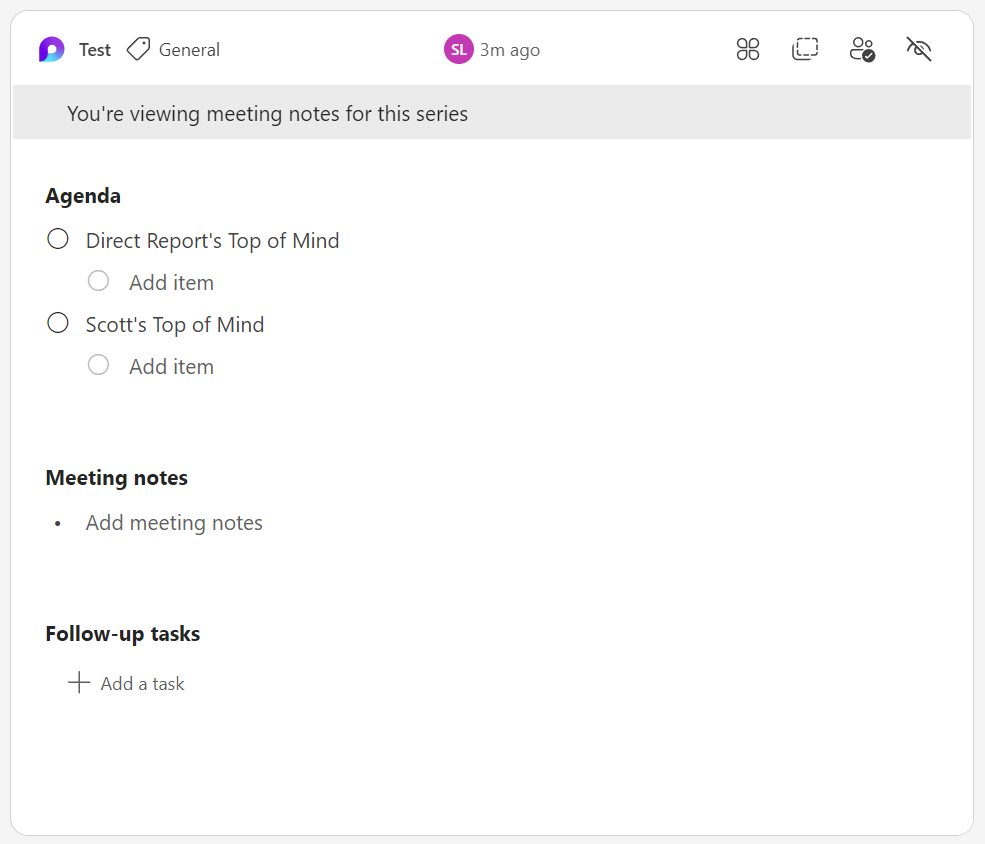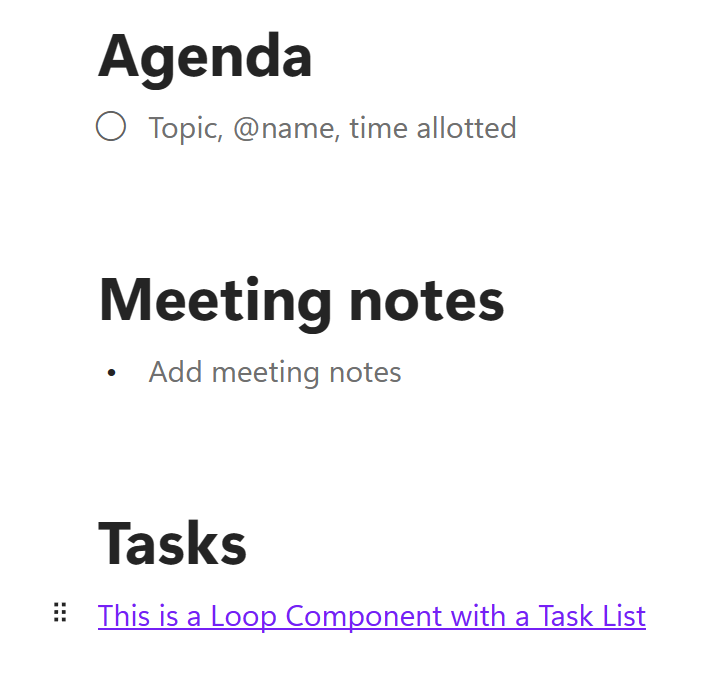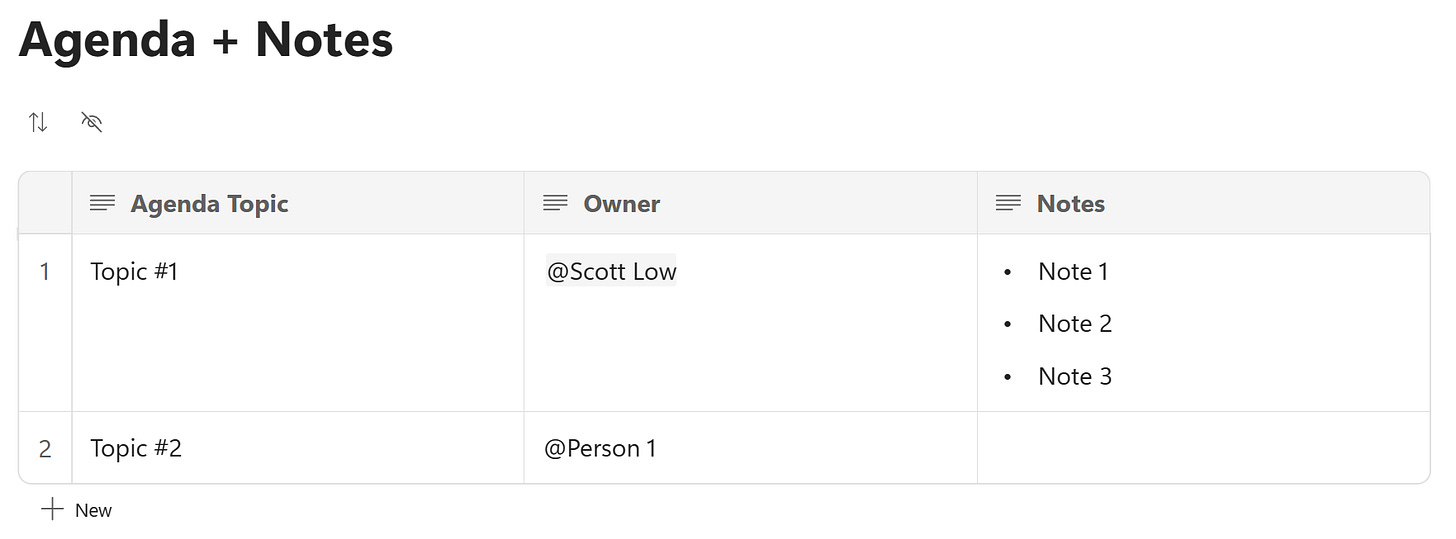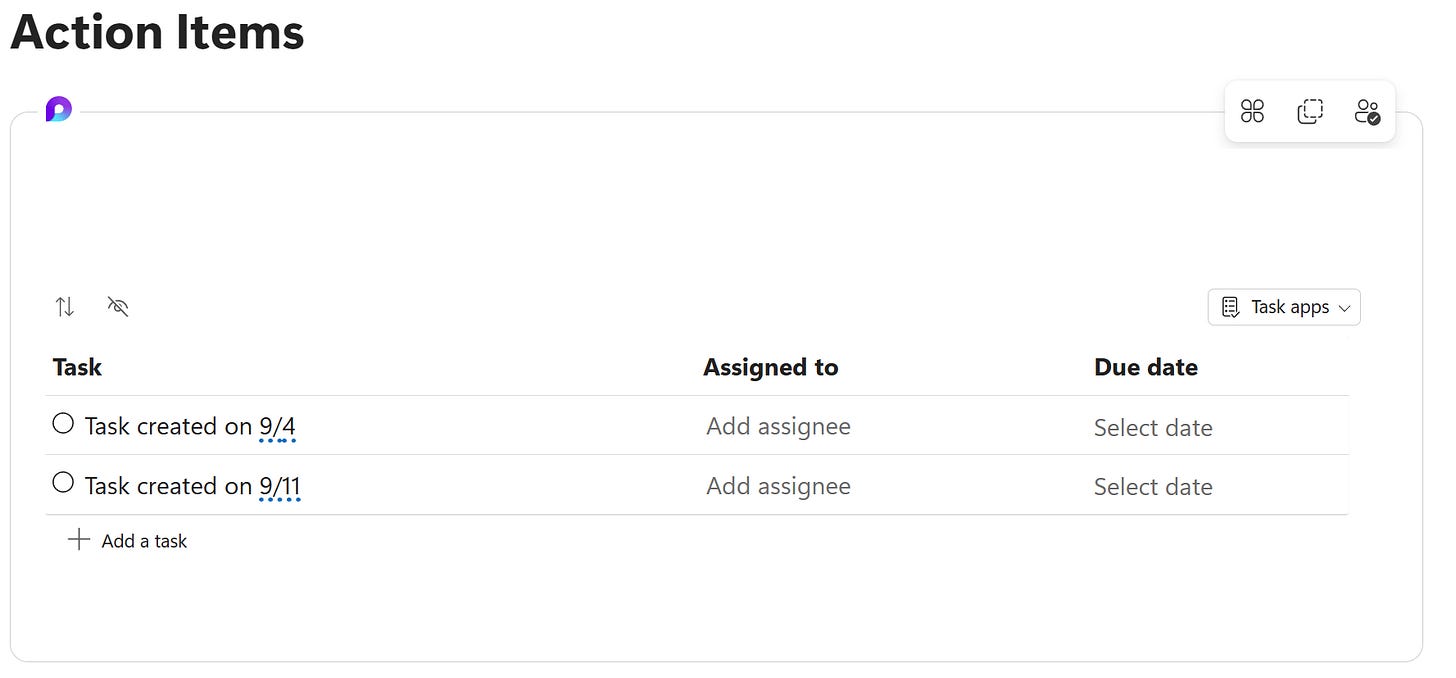In the Loop: Preparing for Meetings with Microsoft Loop
Welcome to the second post of In the Loop, a series on Microsoft Loop by Scott Low
As I grew in my career, two things became true:
I started working with more diverse sets of stakeholders. This meant more regular syncs landed on my calendar.
I started leading a team of Product Managers, requiring me to set aside time for weekly 1:1s.
In both cases, I had the same problem. There were more recurring meetings on my calendar that required agendas defined in advance if they were to be productive. Over the years, I’ve experimented with various solutions to solve this problem. These included the following:
Meeting-specific agenda documents I’d use with collaborators and direct reports to track pressing topics.
Microsoft Planners embedded in Teams chats to track topics for discussion in weekly calls.
Collecting topics in OneNote as they cropped up and sending them in Teams or email as “pre-read” prior to the meeting.
The lack of consistency in topic tracking, coupled with the fact that I'd often need search for agenda docs each week created overhead. There had to be a better way.
Microsoft Loop's deep integration with Microsoft Teams largely solved this problem for me. In fact, it even made my meetings more productive as is summed up nicely by this quote from further down in this post.
Perhaps the most magical thing I've noticed since implementing this practice is the fact that having an agenda that folks regularly reference throughout the week has made meetings more productive by allowing topics to be skipped altogether thanks to asynchronous updates.
Let’s dive into how you too can benefit from this productivity boost.
Getting Started
If you open a meeting you own in the Calendar view of Microsoft Teams, you'll see an option to "Add an agenda others can edit":
Clicking this button creates a set of meeting notes (which, you guessed it, are a Loop Component) before the meeting even starts. The default template is pre-populated with an "Agenda" checklist, a "Meeting notes" bulleted list, and a "Follow-up tasks" Task List (a special type of template I explained in more detail in my first post):
Once created, anyone can edit the agenda prior to the meeting by opening their Teams Calendar and double clicking the meeting. After joining the meeting, this is the same Loop Component that shows up in the “Notes” tab as well:
Pretty nifty, right?
But Wait, There's More!
I know what you're probably thinking: "Cool, but I don't have time to open every single meeting I own—especially ones that are recurring—and add an agenda". I'm with you.
Luckily, Loop makes it possible for agendas to be created by default for recurring meetings. I'll admit, however, that setting this up isn’t the most intuitive flow. You can do this for yourself by following these steps:
Double click an occurrence of a recurring meeting you own from within the Calendar view in Teams.
Click “Edit series” in this banner at the top:
Click “Add an agenda that others can edit” to add an agenda for the series. Once you’ve done this (or if you’ve already done this for an occurrence of the meeting), you should now see a “You’re viewing meeting notes for this series” message along the top:
You have now created and are editing the meeting notes for the meeting series. Think of this Loop Component as a template that the meeting notes Loop Components for subsequent occurrences of the meeting will be cloned from.
Said differently, a meeting notes Loop Component will now be automatically created for each future occurrence of this meeting without you needing to click "Add an agenda others can edit" on each occurrence. Each occurrence’s meeting notes will be a clone of whatever is in the series template you created above. A handy banner will also be displayed to make it clear when you’re viewing meeting notes for an occurrence instead of the series:
If you ever want to change the series template, you can follow the same set of steps above.
Putting This All Together
Series templates have allowed me to create custom templates for all of my recurring meetings without even needing to think. For 1:1s with my direct reports, for example, I use the following template:
This gives us both a well-defined spot that we can use to record any topics that are top of mind the moment we think of them. Plus, since this flow is integrated deeply with the Calendar view in Teams, we both know exactly where to go to do this. No more searching for agenda docs or bookmarked Microsoft Planners.
Perhaps the most magical thing I've noticed since implementing this practice is the fact that having an agenda that folks regularly reference throughout the week has made meetings more productive by allowing topics to be skipped altogether thanks to asynchronous updates. Imagine joining a call and getting to skip some of the more mundane topics since folks have already acknowledged/addressed them in line before the meeting even starts. Pretty powerful stuff.
Key Limitations
Unfortunately, it’s not all sunshine and rainbows. The flow I introduced does come with a couple key limitations.
You Need to Own the Meeting
One such limitation is the fact that you cannot add meeting notes to a meeting (recurring or not) that you don’t own. You can always ping meeting organizers and ask them to configure a meeting notes Loop Component, but then you need to explain the reasoning/benefits (or perhaps you can now just send them this post 😉).
This also means that there's no way to set this up for meeting invites that come from a shared calendar, which is a major drawback for several of the Chief of Staff meetings I run.
Task Lists Don’t Work the Way You Might Want
Another key limitation is the fact that any Task List that is inserted into a series’ Loop Component will be created anew for each occurrence. This makes it challenging to track long running tasks between occurrences since any tasks you enter in one occurrence’s Task List will not persist to the next.
Unfortunately, I’ve yet to find a great workaround for this. I first tried nesting a Loop Component containing a Task List into the series’ Loop Component, but it looks like the Loop Components in Teams’ meeting notes don’t support nested Loop Components. At the time of writing, only a link was pasted instead of an expanded Loop Component:
The second workaround I’ve been using is much more manual, but it gets around both of the key limitations above.
A Hacky Workaround
For meetings I run that are sent from a Shared Calendar, I’ll create Loop Components in the Loop app (https://loop.microsoft.com) instead. These Loop Components support nested Loop Components, meaning I can create persistent Task Lists, but they aren’t integrated with Teams, meaning I need send them to participants in chat every week.
Here’s the step-by-step flow I follow:
Navigate to the Loop app and create a new blank Loop Page in a Workspace of your choice. This will be the Loop Component for a single occurrence of a meeting.
Add an Agenda and Notes section. I’m thinking about experimenting with the following template rather than the one that Teams creates by default for readability:
Create a second Loop Page in the same workspace. This page will be used to store the persistent Task List.
Insert a Task List into that Loop Page.
Select the “Copy as Loop component” option along the top next to the Share button.
Paste the Task List Loop Component into the Loop Component you created in Step 1. You should see the Task List nested within the first Loop Component in an expanded state:
Send the Loop Page you created in Step 1 to meeting participants in chat a couple days before the meeting and ask them to add agenda items/check action items.
Repeat Steps 1-7 for each subsequent occurrence of the meeting.
This workaround isn’t ideal, and I’ll be reaching out to the Loop Product team in the coming weeks to see if I’m overlooking something. In the meantime, however, it solves a few critical needs:
It creates a consistent place for participants to see agenda, notes, and action items.
It lets me create this consistent place ahead of time even if I don’t own the meeting series or it comes from a shared calendar.
It creates an evergreen Task List that can be used to track long-running tasks between occurrences.
Wrapping Up
This was a long post, so thank you for reading if you made it this far. The power of LinkedIn recently got me connected with the Loop team, so I’ll update this post if I learn anything more from them.
I’d also love to hear in the comments if you’re using a different technique to manage meeting notes that’s been working well for you!



